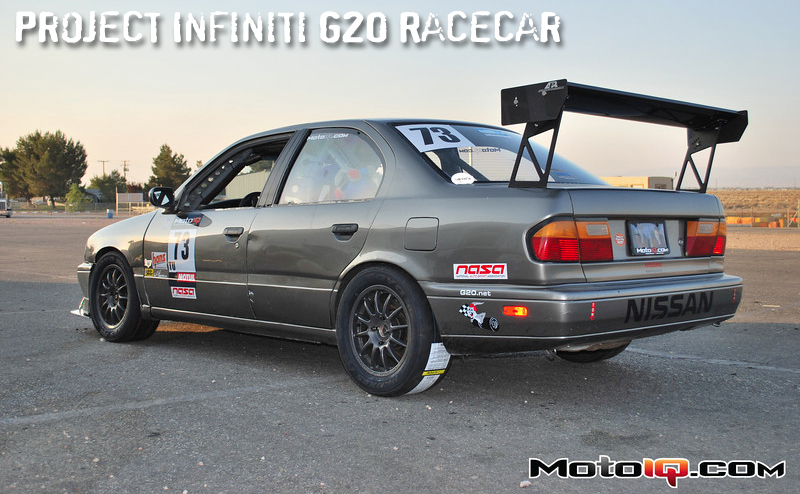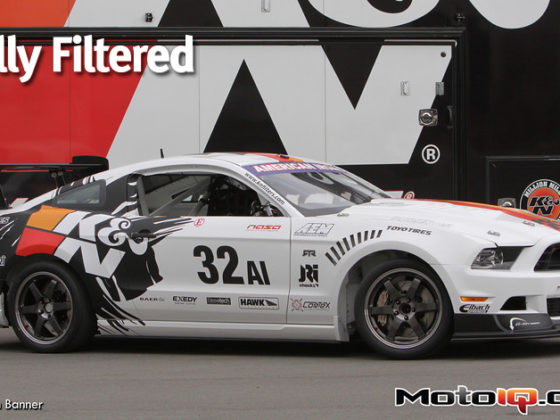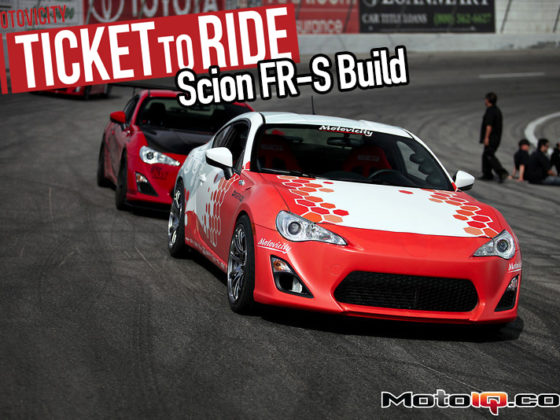,
To make the front splitter, we used Cardboard Aided Design (CAD) to cut out a template that matched the bumper. This was sent to APR with instructions to make the leading edge 4” larger and tapering down to about even with the back edge of the front bumper to give our splitter a 4” long working surface in front of the bumper. APR handled the rest, making our fiberglass with carbon fiber overlay splitter and belly pan out of one piece. Rubber stripping was used to protect the leading edge and APR provided four of their adjustable turnbuckles to properly support the front edge of the splitter.

Mounting the splitter to the bumper proved to be far more difficult than we originally planned it to be. Since we don’t have a Project Trailer custom built to haul our car, getting Project G20 up onto our flat bed (let alone our toy hauler) with a 4” splitter hanging off the front would be nearly impossible without major cursing. Our splitter had to be easily removed. It also needed to be strong. While the panel APR sent us is plenty stiff, it was still being bolted to a plastic bumper, and dealing with 4” of working surface combined with the high speeds we see at our MPTCC events meant that we’d need to make sure the splitter was supported by more than just 20 year old plastic. The only thing about mounting a splitter to Project G20 that was easier than normal was our Euro spec NISMO front bumper, which was not only 3” lower than the stock piece, but was also nice and level with the ground. This meant we would not need to make some sort of filler panel and could mount our splitter directly to the bumper without worrying about the added stress such a filler panel would create.


After squaring the bumper up to the splitter piece and making sure the corners were in a relaxed state (so that we didn’t make the bumper wider or narrower than it should’ve been), we cut a piece of aluminum angle stock to match the width of the bumper, and drilled holes through it, the large flat lip at the back corners of the bumper, and the splitter. Button head bolts with large fender washers were inserted through the holes and we added more bolts along this flat area until we got to the leading edge and ran into our next problem. For whatever reason, Nissan decided to make it more difficult to mount a splitter to the NISMO bumper (bastages!), so we had to improvise. Using more aluminum angle stock, we cut two short pieces and drilled holes through the leading edge of the bumper and ran more hardware through them into the angle stock. The angle stock was then drilled through in three places per side to attach it to the splitter piece. This keeps the bumper attached to the splitter, and a strip of 200mph tape was used to seal any small gaps that resulted from years of racing abuse to the bumper (none of which was my fault, those cones jumped right out in front of me!). To allow the transponder (which is now blocked by the splitter) to work, we added a speed hole directly underneath with a rotozip.
 This angle stock and bolt keep the bumper square to the splitter.
This angle stock and bolt keep the bumper square to the splitter. Three speed holes and a boatload of stainless buttonhead allen bolts secure our splitter/belly pan to our NISMO bumper.
Three speed holes and a boatload of stainless buttonhead allen bolts secure our splitter/belly pan to our NISMO bumper.To keep the front of the splitter stable at speed and adjust pitch as necessary, we added four of APR’s adjustable turnbuckles and bolted them to the bumper support. When we first started using our splitter, we removed these turnbuckles from the splitter and unbolted the bumper from the fenders. This, it turns out, was a tremendous pain in the balls to do every single flipping time. We missed the start of at least two practice sessions dicking around with getting the turnbuckles attached to the bumper support (which was decidedly NOT designed for this, again: bastages!). God help us should we need to actually work on something covered up by the belly pan! Figuring there had to be a better way, we contemplated making guides like Kojima has on his rides, but while we’re not complete idiots at fabrication, we certainly don’t have the kind of talent (or time) to make something like this work well and not end up as crooked as a California State Senator. Luckily, however, Nissan designed the front bumper assembly to be easily attached to the vehicle: the bumper support slides into the “frame” rails at the front of the car, giving us built in guides without all the fuss and sweating (and cursing) that with “fabrication”. To give us access to the bolts, we added more holes directly underneath and covered them up with more 200mph tape to prevent unnecessary air leaks. Amusingly enough (at least to us), feeding bolts through these holes into the distant bumper support reminds us of Star Wars: A New Hope when Luke was trying to feed a proton torpedo into the two meter exhaust vent. Stay on target! Hey, it’s funny to us. Kiss it.





